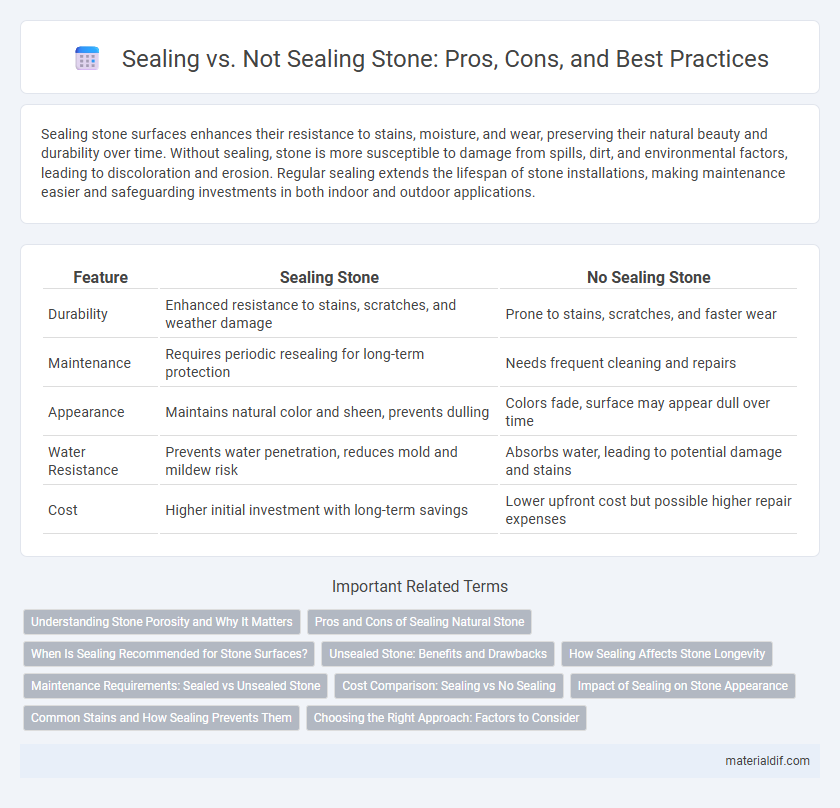Sealing stone surfaces enhances their resistance to stains, moisture, and wear, preserving their natural beauty and durability over time. Without sealing, stone is more susceptible to damage from spills, dirt, and environmental factors, leading to discoloration and erosion. Regular sealing extends the lifespan of stone installations, making maintenance easier and safeguarding investments in both indoor and outdoor applications.
Table of Comparison
| Feature | Sealing Stone | No Sealing Stone |
|---|---|---|
| Durability | Enhanced resistance to stains, scratches, and weather damage | Prone to stains, scratches, and faster wear |
| Maintenance | Requires periodic resealing for long-term protection | Needs frequent cleaning and repairs |
| Appearance | Maintains natural color and sheen, prevents dulling | Colors fade, surface may appear dull over time |
| Water Resistance | Prevents water penetration, reduces mold and mildew risk | Absorbs water, leading to potential damage and stains |
| Cost | Higher initial investment with long-term savings | Lower upfront cost but possible higher repair expenses |
Understanding Stone Porosity and Why It Matters
Stone porosity determines its ability to absorb water, stains, and oils, making sealing essential for porous stones like limestone, marble, and sandstone to protect against damage and discoloration. Unsealed stone allows moisture to penetrate, leading to potential erosion, mold growth, and structural weakening over time. Proper sealing creates a protective barrier that maintains stone durability, appearance, and value by minimizing absorption and extending surface lifespan.
Pros and Cons of Sealing Natural Stone
Sealing natural stone protects it from stains, moisture, and wear by creating a durable barrier, extending the stone's lifespan and maintaining its aesthetic appeal. However, sealing requires regular maintenance and reapplication to remain effective and may alter the stone's natural texture or color. Choosing whether to seal depends on the stone type, usage environment, and desired balance between protection and preserving natural appearance.
When Is Sealing Recommended for Stone Surfaces?
Sealing is recommended for porous stone surfaces such as marble, travertine, and limestone to prevent moisture infiltration, staining, and etching. High-traffic areas like kitchen countertops, bathroom vanities, and outdoor patios benefit from sealing to enhance durability and maintain appearance. Non-porous stones like granite and quartz typically do not require sealing due to their natural resistance to liquids and contaminants.
Unsealed Stone: Benefits and Drawbacks
Unsealed stone allows natural breathability, reducing moisture buildup and promoting a more authentic appearance with its natural texture and color variation. However, unsealed surfaces are prone to staining, weathering, and erosion, making maintenance more frequent and potentially costly over time. Choosing unsealed stone often balances aesthetic preference with the need for regular cleaning and protective measures to preserve durability.
How Sealing Affects Stone Longevity
Sealing stone creates a protective barrier that prevents water, oil, and dirt from penetrating its surface, significantly reducing the risk of stains and erosion over time. Unsealed stone is more susceptible to weathering, discoloration, and structural damage caused by moisture absorption and freeze-thaw cycles. Proper sealing extends the stone's longevity by maintaining its natural appearance and structural integrity against environmental factors.
Maintenance Requirements: Sealed vs Unsealed Stone
Sealed stone requires periodic reapplication of sealant to maintain its protective barrier against moisture, stains, and damage, typically every 1 to 3 years depending on usage and exposure. Unsealed stone demands more frequent cleaning and is more susceptible to discoloration, staining, and erosion due to its porous surface absorbing dirt and liquids. Proper maintenance of sealed stone reduces long-term degradation and preserves appearance, while unsealed stone often incurs higher upkeep costs and effort.
Cost Comparison: Sealing vs No Sealing
Sealing natural stone incurs an initial cost ranging from $1 to $3 per square foot, including labor and materials, while opting for no sealing may lead to higher long-term expenses due to potential stains, etching, and surface damage requiring costly repairs or replacements. Regular sealing extends the stone's lifespan by preventing moisture infiltration and erosion, reducing the need for frequent maintenance that can average $500 annually for untreated stone surfaces prone to damage. Investing in sealing proves cost-effective by minimizing the risk of expensive restoration, which can exceed $10 per square foot compared to untreated stone vulnerabilities.
Impact of Sealing on Stone Appearance
Sealing stone surfaces enhances their resistance to stains, moisture, and discoloration, preserving the natural texture and color vibrancy over time. Unsealed stone is more susceptible to absorbing liquids and dirt, leading to dullness, etching, and long-term surface damage. Proper sealing maintains the stone's polished finish, ensuring a consistent aesthetic and prolonging its visual appeal and lifespan.
Common Stains and How Sealing Prevents Them
Sealing natural stone creates an invisible barrier that repels common stains from substances like coffee, wine, and oil, which easily penetrate unsealed surfaces causing discoloration. Unsealed stone is porous, allowing liquids and dirt to absorb quickly, leading to challenging, often permanent stains. Applying a high-quality sealant preserves the stone's appearance by preventing stain absorption and making cleaning more effective and less frequent.
Choosing the Right Approach: Factors to Consider
Choosing between sealing and no sealing for stone surfaces involves assessing factors such as the stone type, porosity, and intended use. High-porosity stones like marble and limestone benefit from sealing to prevent staining and moisture damage, while denser stones like granite may not require sealing. Consider environmental exposure, maintenance routines, and aesthetic preferences to determine the most effective protection approach.
Sealing vs No Sealing Infographic

 materialdif.com
materialdif.com